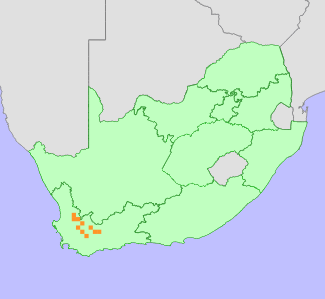|
Scientific Name | Amphithalea villosa Schltr. |
Higher Classification | Dicotyledons |
Family | FABACEAE |
Synonyms | Coelidium euchaetioides Dummer, Coelidium villosum (Schltr.) Granby |
National Status |
Status and Criteria | Near Threatened B1ab(iii,iv,v)+2ab(iii,iv,v) |
Assessment Date | 2021/04/27 |
Assessor(s) | A.L. Schutte-Vlok & D. Raimondo |
Justification | This species has an extent of occurrence (EOO) of 7143 km² and an area of occupancy (AOO) of 88 km². Between ten and 14 subpopulations are known, and it is likely that a few more unrecorded subpopulations exist. Each subpopulation occurs on land which is either privately owned or within a reserve. As grazing by livestock is the main threat to this taxon and grazing pressure is determined by land ownership, between 10 and 20 locations are suspected to exist. There is ongoing decline in habitat quality and the number of mature individuals as a result of livestock overgrazing. This species therefore qualifies as Near Threatened as it is approaching Vulnerable under criterion B1. |
Distribution |
Endemism | South African endemic |
Provincial distribution | Western Cape |
Range | This species is endemic to Western Cape, South Africa, where it occurs along the arid eastern margin of the Fynbos Biome from the Cederberg Mountains to the Wabooms Mountains west of Montagu and the hills around Matjiesfontein. |
Habitat and Ecology |
Major system | Terrestrial |
Major habitats | Matjiesfontein Shale Renosterveld, Matjiesfontein Quartzite Fynbos, Swartruggens Quartzite Fynbos, Northern Inland Shale Band Vegetation |
Description | This species inhabits the transitional arid fynbos, often confined to shale bands. |
Threats |
| Livestock grazing was a severe past threat, and remains a present and future threat. There has been an observed decline in the number of individuals in the subpopulations at Konstabelberg and Tweedside near Laingsburg due to overgrazing by goats. A subpopulation at Rooihoogte Pass on the Waboomsberg near Montagu is also heavily impacted by grazing. |
Population |
Between ten and 14 subpopulations are known, and it is likely that a few more unrecorded subpopulations exist. Recent monitoring data on iNaturalist indicates the the subpopualtiosn can be small consisting of 50 to 100 individuals.
|
Population trend | Decreasing |
Notes |
| Most populations are found around Laingsburg but there are a few collections from the Cederberg that appear to be most similar to the Laingsburg group. However, this is a resprouter while the Laingsburg populations are reseeders. Given that both these forms are described as one taxon they are both included in this assessment. Subpopulations in the Laingsburg area are severely threatened by overgrazing, while those in the Cederberg are unlikely to be threatened. |
Assessment History |
Taxon assessed |
Status and Criteria |
Citation/Red List version | | Amphithalea villosa Schltr. | NT B1ab(iii,iv,v) | 2015.1 | | Amphithalea villosa Schltr. | EN B1ab(iii,iv,v) | Raimondo et al. (2009) | |
Bibliography |
Goldblatt, P. and Manning, J.C. 2000. Cape Plants: A conspectus of the Cape Flora of South Africa. Strelitzia 9. National Botanical Institute, Cape Town.
Granby, R. 1980. Revision of the genus Coelidium (Liparieae-Fabaceae). Opera Botanica 54:27-35.
Raimondo, D., von Staden, L., Foden, W., Victor, J.E., Helme, N.A., Turner, R.C., Kamundi, D.A. and Manyama, P.A. 2009. Red List of South African Plants. Strelitzia 25. South African National Biodiversity Institute, Pretoria.
Schutte, A.L. 1998. A re-evaluation of the generic status of Amphithalea and Coelidium (Fabaceae). Taxon 47:55-65.
|
Citation |
| Schutte-Vlok, A.L. & Raimondo, D. 2021. Amphithalea villosa Schltr. National Assessment: Red List of South African Plants version 2024.1. Accessed on 2026/01/03 |
 Comment on this assessment
Comment on this assessment


